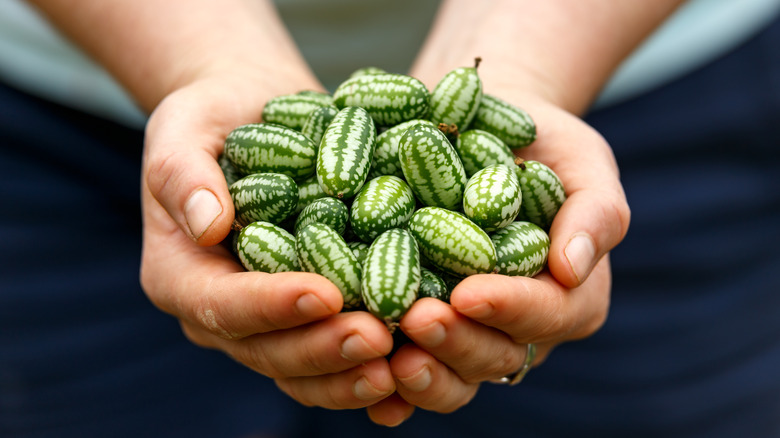Cucamelons Are The Cute Fruit That Looks Like A Mini Watermelon
Having a fridge full of colorful foods is a surefire sign that you've been enjoying a healthy, balanced diet. But sometimes, our go-to fruits and veggies can get a bit boring. Eating the same food every day can leave you feeling uninspired in the kitchen. But shaking things up in the produce department can be daunting — there's always so much to choose from. And sometimes, we don't even know what all of the produce is.
A cucamelon, for example, is a tiny little fruit that resembles a miniature watermelon. But they're not watermelons at all, and when you cut them open to discover a cucumber texture on the inside, you might be surprised to find out that they're not related to cucumbers either. Cucamelons are their very own breed of fruit teeming with a wide range of health benefits.
All you need to know about cucamelons
Cucamelons are native to Mexico and Central America, which is why many Americans aren't familiar with the nanoscopic fruit. Although they're not native to The United States, cucamelons are in season during the late summer months and you may be able to find them at your local grocery store around the same time.
When it comes to flavor, cucamelons taste a bit like a cucumber but with a tangy, sour punch — think of a cucumber drizzled with lime juice. They're covered in a semi-hard rind, but it's not uncommon to eat them whole in one bite. After all, they are only the size of a grape!
Good news for health aficionados, a cucamelon is also considered a superfood. They're high in soluble fibers that improve digestion and are equipped with antioxidant and anti-inflammatory elements that help prevent disease. They also boast a healthy serving of potassium, vitamin C, and Beta-Carotene which protects brain function.
Cucamelons are great enjoyed raw, scooped into a salad, mixed into a batch of homemade salsa, pickled in a jar, or even as a garnish for a martini!
Happy cucamelon eating!

